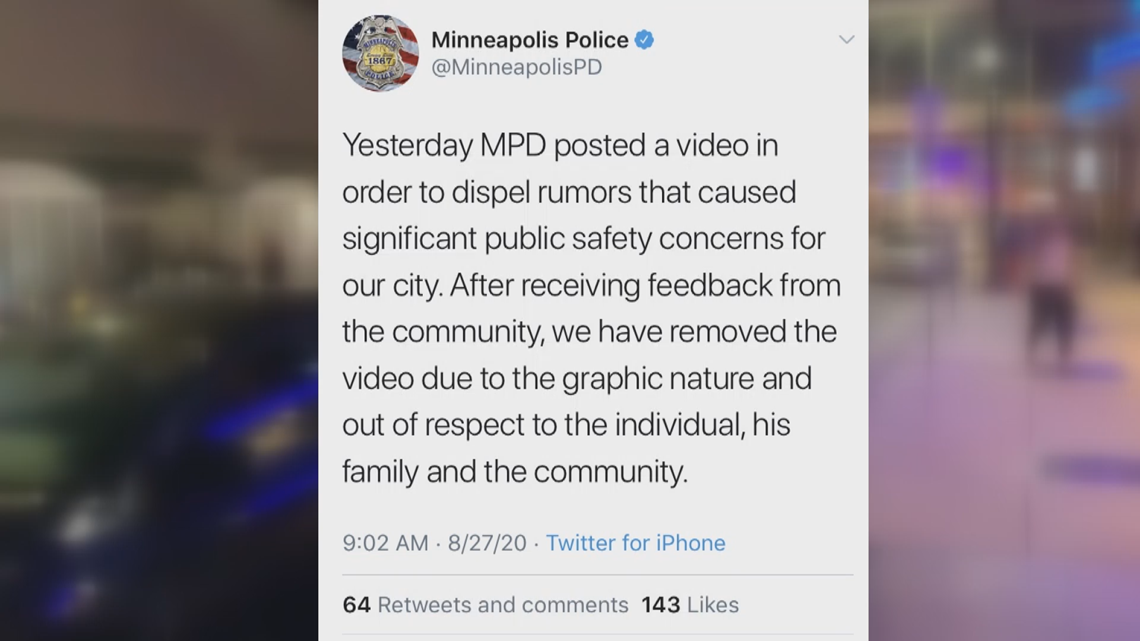MINNEAPOLIS — Unrest began in downtown Minneapolis Wednesday evening as a false rumor swirled about police shooting a man near Nicollet Mall.
Video captured by a city surveillance camera proved those rumors were false. The video showed the man taking his own life.
As the unrest continued, Minneapolis Mayor Jacob Frey and Minneapolis Police Chief Medaria Arradondo made the decision to publicly release the video showing the suicide which was shown to reporters within 90 minutes of the incident, according to MPD spokesperson John Elder who spoke with KARE 11 by phone Thursday.
Elder said the decision was made to "thwart civil unrest or at least minimize it" by dispelling the rumor which had started the unrest, which included people looting stores and setting fire to businesses.
Later, the Minneapolis Police twitter account posted the raw video of the suicide, which showed the moment the man took his own life.
Elder told KARE 11 he made the call to put the video on Twitter, with autoplay disabled and the Mayor and Chief's knowledge.
The tweet was removed by Thursday morning after Elder said its "purpose had been served." A new tweet explained the decision, saying the video had been posted to "dispel rumors that caused significant public safety concerns."


Dr. Dan Reidenberg, Executive Director of Suicide Awareness Voices of Education (SAVE) said he was "disturbed" by the MPD's decision to post video of the suicide.
"I was concerned about the ramifications of what might happen if that video is out," Reidenberg said.
Reidenberg said his first concern was that the video showed the man's method of taking his own life, which he said increases the risk that others who are contemplating suicide and see the video might do the same.
"The more a video like that is seen and the more it reaches people who are at risk, the more likely it is we might have other tragedies," he said.
His next concern was secondary trauma to those who saw the video on Twitter. He added that sharing the video, on a medium like Twitter, oversimplified the complex subject of suicide.
"There are many things that go into a suicide. So for us to see a video like that, that could lead somebody to think that there was one thing behind that death, was unfortunate," he said. "Twitter is a very fast medium and there's very little context that goes into it."
Reidenberg said he understood the difficult situation the department was in Wednesday evening, but suggested they could have provided a link to the video hosted on another site with more context.
Jennifer Hellman, COO of Goff Public, specializes in corporate crisis communication. While she has never worked with the MPD, she noted the difficulties that go into making a decision in a crisis, when speed is a factor.
"All of crisis communications is in a gray zone," she said. "The most important thing an organization can do is to get really clear on what their values are and what is going to drive their decisions before those decisions need to happen."
Hellman said decisions need to balance an organization's values with transparency, but an important factor in all of it is that an organization have the trust of its audience. In the case of the MPD, that would be the community.
"You can see that they're starting with a [trust] deficit, right?" she said. "That's not even a value judgment that I'm making about them. But just with everything that has happened, and with so much conflicting information that has gone out over the summer, it's really hard to be any organization that's starting with a deficit of trust. So in those moments you might make decisions differently than you did before."
If you or anyone you know needs to reach out for help, call the National Suicide Hotline at 1-800-273-TALK. Professionals are available 24/7 to help you talk through your feelings.

